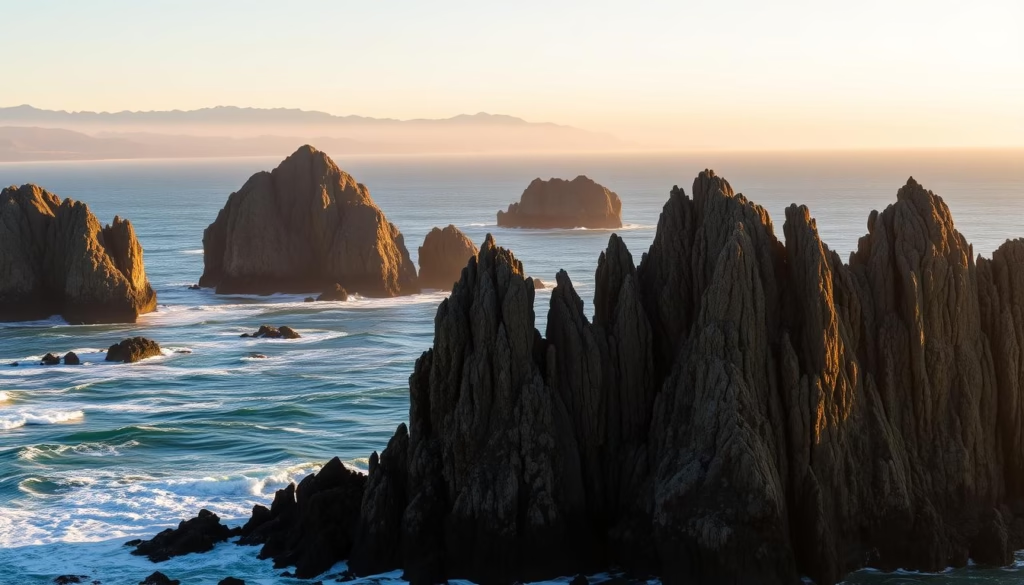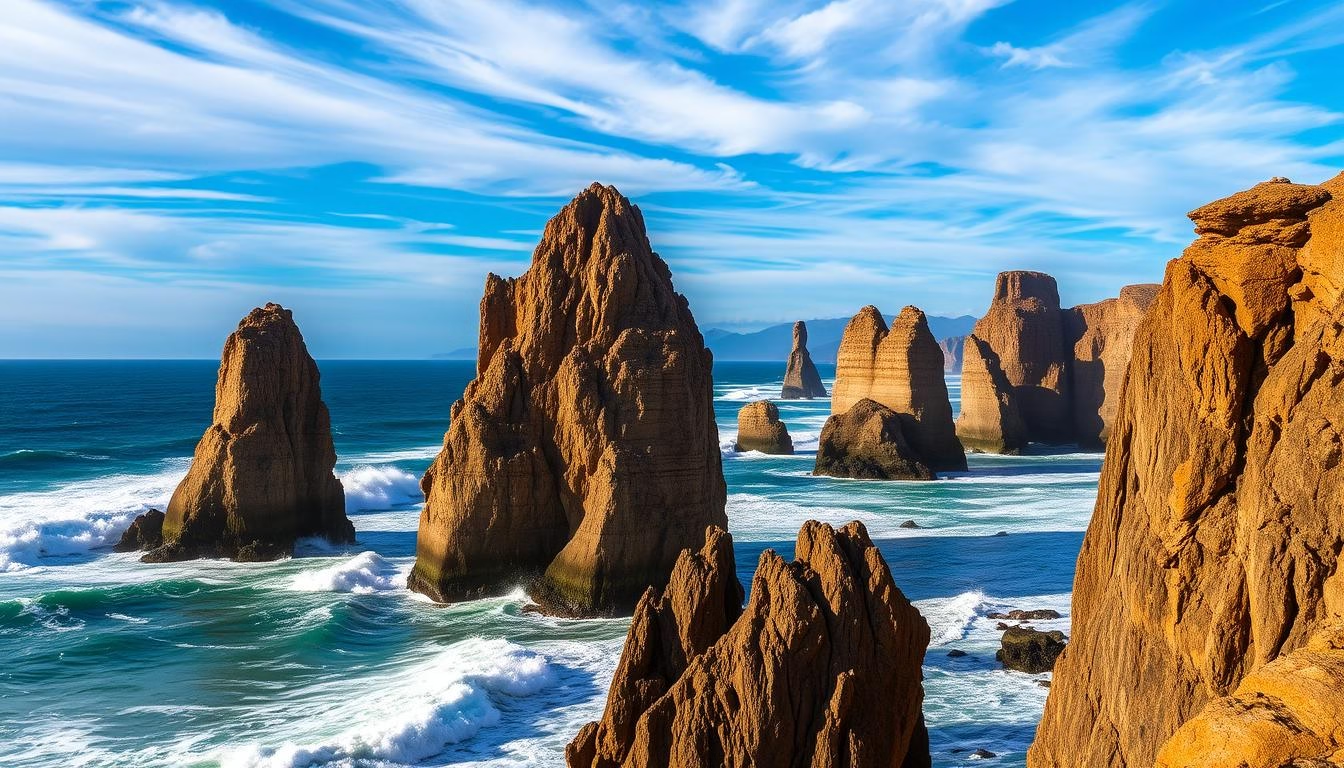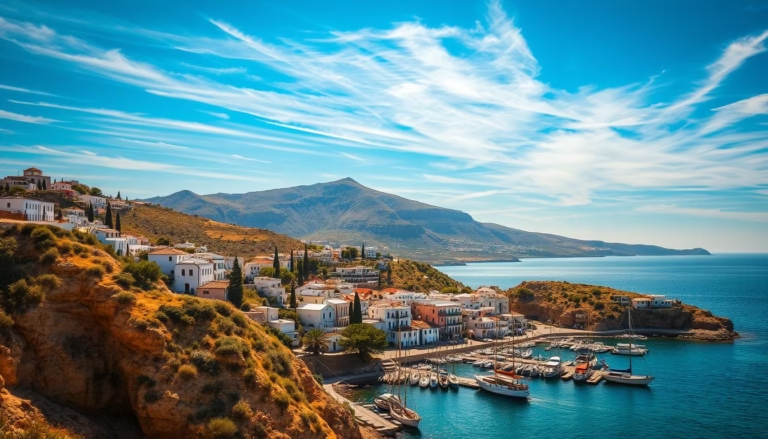Spectacular Sea Stacks: Nature’s Unique Rock Formations
Welcome to a journey through Earth’s coastal wonders. Along rugged shorelines, wind and water carve towering stone pillars that defy time. These natural sculptures—often called sea stacks—stand as testaments to millions of years of erosion. Waves chip away at cliffs, leaving behind isolated columns that rise like sentinels from the ocean.
These geological marvels aren’t just eye-catching landmarks. They create microhabitats for seabirds, seals, and marine life. From Scotland’s windswept coasts to Thailand’s tropical beaches, each rock formation tells a story of Earth’s raw power. Climbers scale their faces, while photographers chase golden-hour light dancing across their surfaces.
Many of these sites hold UNESCO World Heritage status or serve as protected parks. Their fragile beauty reminds us to balance exploration with conservation. Whether you’re a geologist decoding their layers or a traveler seeking awe-inspiring views, these formations connect us to nature’s artistry.
Key Takeaways
- Coastal erosion shapes sea stacks over millions of years
- Found globally, from icy northern shores to tropical coastlines
- Support diverse ecosystems with unique wildlife
- Popular destinations for adventure sports and photography
- Many are protected as natural or cultural heritage sites
Introduction: A Journey into the World of Sea Stacks
Earth’s coastlines hide nature’s stone masterpieces. Wind and waves carve dramatic rock towers that rise like ancient guardians from the ocean. These formations—found on every continent—reveal stories of shifting shorelines and relentless erosion.

For thousands of years, people have woven myths around these coastal giants. Scottish legends speak of petrified giants, while Pacific Northwest tribes honor them as spiritual landmarks. Today, they inspire photographers and geologists alike.
Their global spread tells a geological tale. Limestone pillars thrive in warm waters near Thailand, while volcanic columns dot Iceland’s shores. Each coastline leaves its signature in the stone.
These formations do more than dazzle visitors. They shelter puffins on foggy cliffs and harbor crabs in tidal pools. Rangers balance trail access with habitat protection, ensuring rare species survive.
Improved hiking trails and eco-tours now let travelers witness these wonders responsibly. As sunset paints Oregon’s Haystack Rock gold, we’re reminded: nature’s art deserves both admiration and care.
Defining Sea Stacks: Unique Natural Rock Formations
The story of these stone giants begins with relentless natural forces. Coastal cliffs gradually transform into freestanding pillars as wind and waves chip away at weaker rock layers. This process creates isolated towers that stand like nature’s skyscrapers along shorelines.
Formation Through Erosion
Cliffs don’t become stacks overnight. Waves target cracks in coastal rock walls, while saltwater weakens stone over centuries. Stronger sections remain standing as surrounding materials crumble. Some formations take shape over 10 million years—a blink in geological time.
Wind patterns and storm surges add finishing touches. These elements sculpt arches and caves that eventually collapse, leaving behind rugged pillars. Each groove tells a tale of nature’s persistent editing.
Diverse Rock Compositions
Not all coastal towers are created equal. Basalt resists erosion better than soft sandstone, creating sturdier columns. Limestone stacks often develop pockmarked surfaces from dissolving minerals. Granite formations withstand pounding waves but slowly shrink from frost action.
These differences matter for local ecosystems. Cracks in sandstone host nesting seabirds, while tidal pools at granite bases shelter crabs. Even as erosion reshapes them, these stone sentinels keep giving life a foothold.
Geological Processes Shaping Sea Stacks
Coastal rock formations emerge from an epic battle between land and ocean. Waves pound cliffs relentlessly, while wind carries abrasive particles that sandblast surfaces. Over millennia, these forces transform solid headlands into isolated towers standing guard along shorelines.
Wind, Waves, and Weathering
Wave energy focuses on protruding land areas, wearing down weaker rock layers first. Saltwater seeps into cracks, expanding as it freezes in colder climates. This freeze-thaw action splits stone apart like nature’s chisel.
Wind contributes through salt spray that eats away at mineral bonds. In tropical zones, acidic rainwater dissolves limestone, creating pitted textures. Tidal changes and storm surges accelerate erosion, undercutting formations until portions collapse dramatically.
These processes never pause. What we see today represents mere moments in geological time—some stacks took 10 million years to form, while others vanish within decades. Each groove and notch records Earth’s enduring transformation.
Iconic Sea Stacks in the United Kingdom
Britain’s coastlines showcase geological drama through legendary stone pillars. Three formations stand out for their stories and striking profiles—each revealing different chapters of coastal evolution.
Old Harry Rocks & The Needles
The chalk towers of Old Harry Rocks guard Dorset’s Jurassic Coast. Local lore claims the name comes from a pirate nickname for the devil. By 1896, erosion claimed “Old Harry’s Wife”—a companion stack now reduced to a wave-washed stump.
Westward near Isle of Wight, three creamy-white pillars rise from turquoise waters. The Needles’ lighthouse has warned ships since 1859. Kayakers often paddle close to these cliffs, spotting seabirds nesting in weathered crevices.
Old Man of Hoy Highlights
Scotland’s Orkney Islands boast the UK’s tallest sea stack—a red sandstone giant towering 450 feet. Formed less than 400 years ago, this young formation began as an arch before storms reshaped it into a lone pillar.
Adventurers climb its face for unmatched views, while boats circle its base to admire layered colors. Unlike ancient chalk rocks, Hoy’s stack shows how quickly nature can create—and alter—coastal landmarks.
These formations double as ecological hubs. Puffins dart around The Needles, while fulmars nest on Hoy’s ledges. Guided tours help visitors appreciate both their beauty and fragility.
Breathtaking Sea Stack Wonders from Australia
Australia’s southern edge reveals some of Earth’s most dramatic coastal artistry. Along Victoria’s Great Ocean Road, limestone giants rise from churning waters, shaped by 20 million years of ocean forces. These natural landmarks blend raw power with delicate ecosystems, drawing over two million visitors annually.
The Tale of the Twelve Apostles
Originally dubbed “Sow and Piglets” by sailors, these formations earned their grander name in the 1920s. Though only eight pillars remain after a 2005 collapse, their majesty persists. Waves continue reshaping the coastline, carving new caves that might one day become stacks.
The area thrives with life despite harsh conditions. Southern Ocean swells feed nutrient-rich waters, supporting:
- Dense kelp forests sheltering crayfish
- Nesting sites for little penguins
- Migrating whales visible from cliff trails
Venture 600km northeast to find Ball’s Pyramid, Earth’s tallest sea stack. This volcanic spire near Lord Howe Island soars 1,844 feet—higher than Chicago’s Willis Tower. Its sheer walls challenge climbers, while rare insects thrive in its microclimates.
Parks Victoria manages these sites carefully, using elevated walkways to protect fragile dunes. Rangers monitor erosion while educating visitors about the dynamic balance between tourism and preservation. As sunset paints the Apostles gold, it’s clear why these formations symbolize Australia’s wild beauty.
Marvels on the U.S. Coast: North American Sea Stack Gemstones
Along Oregon’s windswept shores stands a natural monument that captivates scientists and travelers alike. Haystack Rock dominates Cannon Beach’s coastline, its 235-foot basalt frame visible for miles. This iconic attraction draws over 200,000 annual visitors while sheltering delicate ecosystems.
Haystack Rock Insights
Twice daily, receding tides reveal a temporary path to this geological giant. Explorers discover starfish clinging to its surface and hermit crabs scuttling through tide pools. Look up during summer months to spot tufted puffins nesting on upper ledges—their bright beaks contrasting with the dark stone.
The Haystack Rock Awareness Program trains volunteers to protect this intertidal wonder. They teach beachgoers to:
- Step carefully around fragile anemones
- Avoid disturbing seabird colonies
- Respect seasonal wildlife closures
Winter storms transform the rock’s appearance, carving fresh patterns into its base. Rangers update trail maps annually as shifting sands reshape access points. Whether you’re photographing sunset reflections or studying tidal zone biodiversity, this coastal landmark offers endless discovery.
Natural Habitats: The Wildlife Behind Sea Stack Mystique
These coastal towers aren’t just rocks—they’re thriving ecosystems in disguise. Rising like natural fortresses from the waves, they provide safe nesting grounds away from mainland dangers. Their isolation makes them perfect shelters for creatures seeking protection from predators and human activity.
Bird Colonies and Marine Life
Germany’s Lange Anna—nicknamed “bird rock”—hosts over 15,000 breeding pairs of fulmars and gannets each summer. These feathered residents cram into every available crevice, transforming stone surfaces into living tapestries of wings and calls. Migratory species like puffins use these formations as seasonal pit stops during transoceanic journeys.
The surrounding waters burst with life too. Nutrient-rich currents support krill swarms that attract whales and seals. Tidal pools at the base of these formations become miniature worlds where crabs scuttle and anemones wave.
Balancing human curiosity with habitat protection remains critical. Rangers use timed visitation slots and binocular-equipped viewing platforms to minimize disturbances. As climate shifts alter migration patterns, scientists monitor nests to understand impacts on breeding success.
Kayak tours now offer eco-friendly ways to observe wildlife without encroaching on sensitive areas. On remote islands off Alaska’s coast, tourists watch bald eagles swoop between rocky perches—a reminder that these stone giants serve nature first, and humans second.
Sea Stacks as Adventure and Climbing Destinations
Vertical adventures meet coastal drama on these natural rock towers. Climbers worldwide seek their weathered faces, where technical skill battles unpredictable elements. Access remains limited—many formations are protected or require complex approaches. Those who reach the base face tides, crumbling rock, and ever-changing weather.
Challenges and Climbing Tips
Conquering these towers demands more than ropes and carabiners. Tasmania’s 65-meter Totem Pole—first scaled in 1968—requires navigating ocean swells before touching rock. Faroe Islands climbers spent 36 hours battling Trøllkonufingur’s crumbling basalt in 2022, documenting their harrowing ascent.
| Formation | Height | First Ascent | Key Challenge |
|---|---|---|---|
| Totem Pole (AU) | 213 ft | 1968 | Tidal access window |
| Trøllkonufingur (FO) | 313 ft | 2022 | Unstable rock structure |
| Old Man of Hoy (UK) | 450 ft | 1966 | Sheer sandstone face |
Safety Considerations
Timing proves critical. Teams plan climbs around low tides and stable weather—a narrow way to avoid being stranded. Saltwater corrodes gear faster, requiring stainless steel hardware. Rangers now limit permits during nesting seasons to protect bird colonies.
Guided climbs offer safer time-sensitive experiences. Instructors teach:
- Wave pattern analysis
- Emergency retreat protocols
- Leave-no-trace anchoring methods
As interest grows, climbers debate conservation versus conquest. Some routes close permanently when erosion accelerates. The end goal? Preserve these natural challenges for future generations while respecting their fragile ecosystems.
Exploring the Majestic Faroe Islands Sea Stacks
The Faroe Islands’ coastal wonders blend myth with raw geology. Each island holds stone formations carved by relentless North Atlantic forces. Visitors discover dramatic arches and towering pillars that challenge explorers while guarding ancient legends.
Drangarnir Sea Arch
Vágar Island’s star attraction demands effort to witness. The challenging hike from Sørvágur village spans three hours each way across rugged terrain. Boat tours from the local marina offer safer access, while hybrid excursions combine a 25-minute walk with coastal cruising for optimal views of this natural arch.
Risin & Kellingin Legends
Near Eysturoy Island, two stone sentinels rise from the waves. The 233-foot Risin (“Giant”) and his 223-foot “Wife” Kellingin feature a wave-carved hole through her base. Reach Tjørnuvík village on Streymoy Island for prime photography—just 45 minutes by car from the capital. Time your visit at low tide to see their full majesty.






